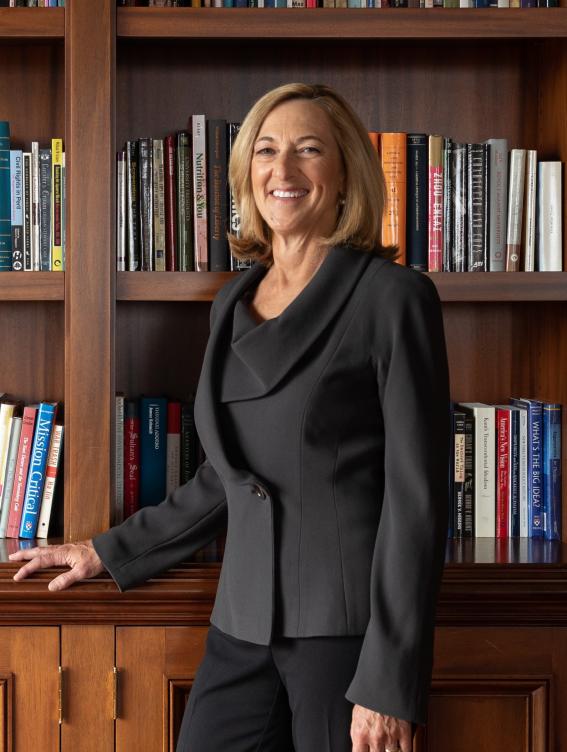Susan Fournier ’80 Is the New Academic Dean at BU’s Questrom School of Business
March 22, 2019

When Susan Fournier dissects business and business school cultures, smart folks pay attention. An eminent voice in branding and consumer behavior, she has—among numerous accomplishments—pioneered marketing’s brand relationships subfield, which explores consumer connections with branded products, services, and organizations. “For me, understanding culture is critical,” emphasizes Susan, whose work draws on marketing, psychology, anthropology, and finance. Those passions have yielded scores of articles in key academic journals, two influential books on branding, and forty Harvard Business School case studies. With those credentials, the Questrom School was on safe ground in choosing Susan last summer as its first “academic dean” in four decades.
Her Launch at Isenberg
“My undergraduate years at Isenberg truly shaped my career,” Susan affirms. A first-generation college student from Woburn with skills in math, she began at UMass in computer science, switched to accounting, and then found her true love—marketing. It was the late 1970s, and marketing at Isenberg was rocking, with the likes of Charlie Schewe, Marc Weinberger, Bill Dillon (now at SMU), Charlie Schaninger (now at SUNY Albany), and Chris Allen (now at the University of Cincinnati) on its faculty.
“The then–School of Business gave me a solid foundation in research methods and consumer behavior,” Susan recalls. Susan and her “best friend for life,” Kate Prescott ’80, both gravitated toward marketing research and statistics, an area spearheaded by Dillon and his research alter ego, subsequent Isenberg PhD graduate, Tom Madden. Thriving in the classroom and as research and teaching assistants, Susan and Kate offered zero resistance when Bill and Tom insisted: “You guys have to go to grad school!” (Dillon and Madden also advised the two undergraduates in their own marketing research start-up supporting local Amherst businesses.)
After gaining admission to graduate programs at five colleges and universities, Susan and Kate chose Penn State’s research-oriented MS in Marketing program, where they largely enrolled in PhD seminars. Two years later, with master’s degrees in hand, both went into industry. Kate founded her own consulting firm, Prescott & Associates, and Susan thrived as a marketing researcher at Polaroid and Yankelovich Clancy Shulman. After that, she worked for several years in advertising as a senior vice president with Young and Rubicam on such brands as Jell-O, AT&T and Adidas.
Academia Redux
In the late 1980s, Susan returned to Isenberg as a PhD student, where she gained rigorous training and nuanced skills in consumer behavior research from Charlie Schewe, Chris Allen, Kathleen Debevec, and other professors. “It was Kathleen who introduced me to the newly expanded field of consumer behavior, which became the foundation of my research,” Susan recalls. “By instilling confidence and reinforcing my love of learning, the program helped me rise to the next level,” she adds. Two years later, Susan and her now-husband, Morgan Evans, joined PhD programs at the University of Florida. The move allowed them to stay together while students in their respective programs—Morgan in physics and Susan in marketing.
Since earning her PhD in 1994, Susan has never looked back, excelling as a teacher, researcher, and academic leader at the Harvard Business School (1994-2004), the Tuck School at Dartmouth (2004-2005), and Boston University’s Questrom School of Business (2006 on). She arrived at BU as an associate professor, was promoted to full professor in 2012, and earned the distinction of Questrom Professor in Management in 2013. That same year, she launched the non-profit Institute for Brands & Brand Relationships, dedicated to advancing branding through collaborations between academics and practitioners. In August, she became the first woman to serve as dean at Questrom.
“One of my principal objectives as a dean is to create community,” Susan remarks. In that enterprise, Isenberg, she says, is worthy of emulation. “When I return to Isenberg for marketing seminars, I always observe the positive relationships between faculty members and the PhD students. The faculty openly embrace the students and their development. In my own student days, the faculty were the same positive role models. They gave, and gave, and gave to my classmates and me. As far as I can see, little has changed in Isenberg’s positive culture.”